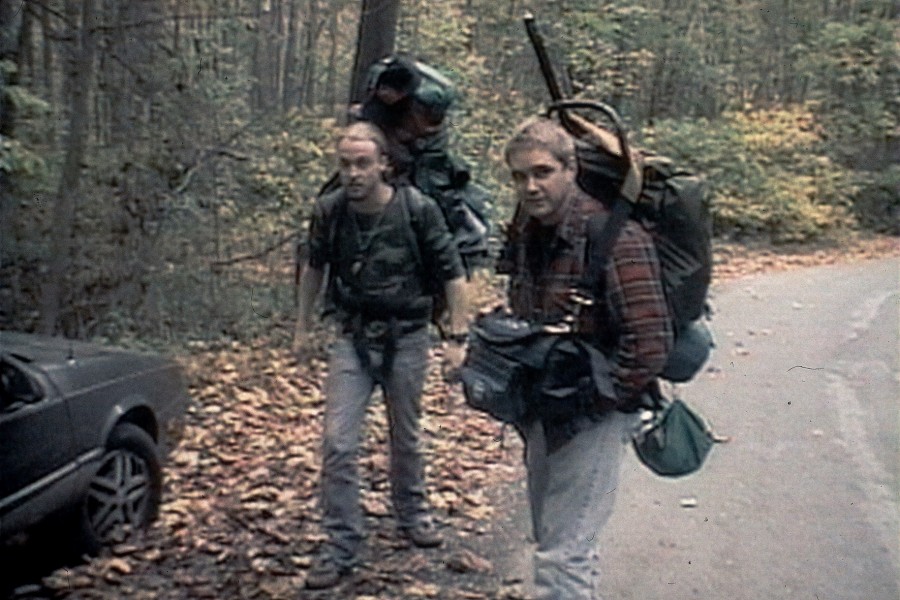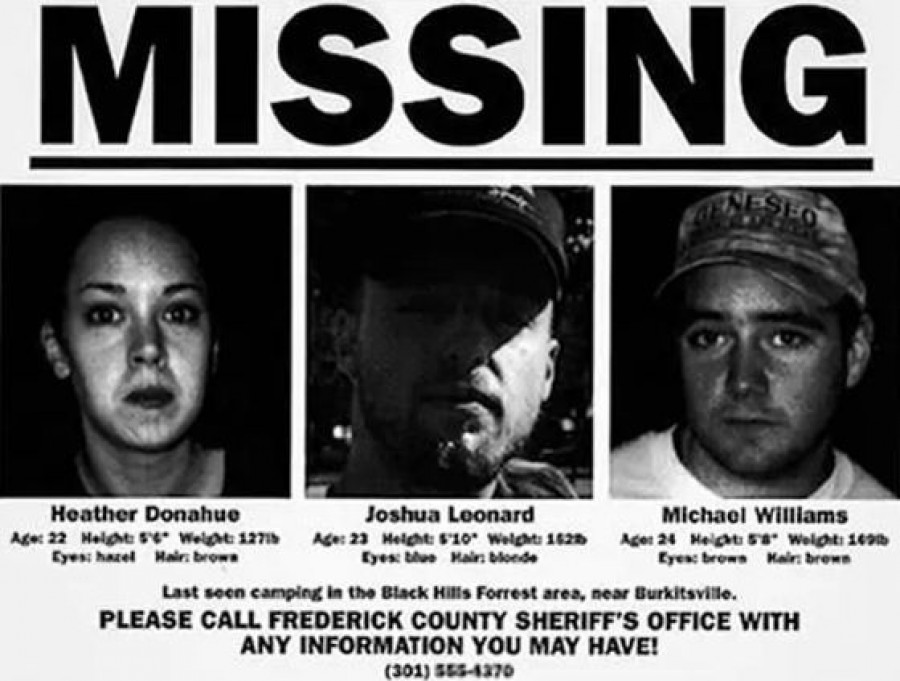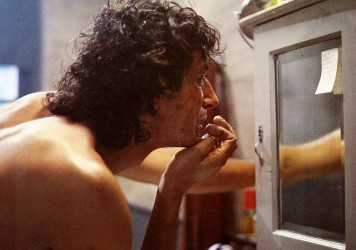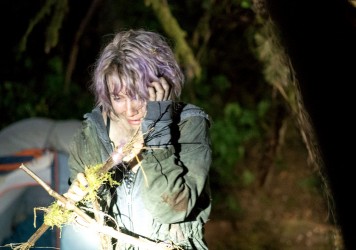
We came up with the basic premise for what eventually became The Blair Witch Project back in the early ’90s. We were studying at the University of Central Florida at the time, and like most college students we didn’t have any money. So we’d pretty much just hang out and do whatever we could afford to, which often involved watching movies. Our favourite horror movies were things like The Exorcist, The Shining, The Amityville Horror and Jaws. One day we got to talking about this show called In Search of…, which Leonard Nimoy hosted in the ’70s. We started thinking about all these pseudo-documentaries like The Legend of Boggy Creek, In Search of Noah’s Ark, Chariots of the Gods, exploratory, investigative films linked to paranormal encounters, and how they really freaked us out as kids. So we rented a bunch of those movies and we were surprised how much they still freaked us out.
We wanted to do the same thing for modern audiences. So we came up with this idea of a group of student filmmakers investigating some local legend; they disappear, and their footage is found years later. That’s how the original concept was born, but we shelved it to concentrate on other projects we were working on at the time. Then in ’96 we returned to this “Woods Movie”, as we were still calling it up to that point. We pitched it to Gregg Hale, who was one of the first producers to come on-board, and he immediately got the ball rolling. But we still didn’t have a name. Ed’s older sister had gone to Blair High School, and we were both huge fans of Linda Blair… It just seemed like a believable name, and it ended up sticking.
“It’s the only time in our careers where we didn’t even know the rules we were breaking.”
Our original vision was very much like an In Search of… episode. It was supposed to be more of an investigative documentary about the Blair Witch, featuring interviews with the parents and the investigators. We shot the movie in two sections: phase one, which is everything in the woods, and then phase two, which ended up being used for the Curse of The Blair Witch TV documentary. The phase one stuff was shot over about eight pretty intensive days. It was a continuous shoot, where the actors were the cameramen and all the dialogue was improvised.
People don’t realise how much work went into creating the stage for the actors to perform. The logistics of navigating three actors through the woods was a constant challenge. Everything had to be meticulously thought out and planned. We were in those woods working on pre-production for almost a month, using GPS systems to set up all the different waypoints where the guys would be camping. We wanted to limit our contact with them, so at first we just sort of shadowed them. We set up these areas – we thought of them as directing nodes – where we could watch the actors. But then we couldn’t actually hear them, so we abandoned that pretty quickly.
At that point it became about building a world around the actors, giving them only the most basic logistical information they needed. We had to make sure they had food and water, the batteries in the camera had to be charged – all that technical stuff. Most of the time we were either prepping the next scene – putting stick men in the trees for example – or planning the next day. It was very tiring and exhausting for all involved. Of course, it was also a very exciting time for us. It’s the only time in our careers where we didn’t even know the rules we were breaking.
But we still didn’t have an ending. We hadn’t quite figured out what would happen in that house. How do you shoot a satisfying ending to this movie? That was a big thing for us. The ending we eventually came up with was a very spontaneous idea which we executed very quickly. That’s really the story of the film: it was all done very quickly and spontaneously. We still kept around 95 per cent of the original beat of the movie and the script. Somehow we managed to get all those original ideas on video.

We ended up with so much footage – something like 20 hours – that could have been edited to make a much longer film, and we wouldn’t have had to repeat anything. There were only two scenes that required us to do multiple takes. So it became a case of having to decide what to cut. For example, with Heather’s confession at the end, Mike did a confession too. We had to figure out which one was more relevant, and we went with Heather’s because she was leader of the project and she had more to apologise for than Mike did.
After editing phase one into a rough three-hour cut, we put on a test screening for some of our closest friends at the Enzian Theater in Orlando, mostly to help us decide how much backstory to put in and how much of the documentary stuff did we needed. We had everyone fill in a questionnaire about the film – what additional information they wanted to know about the story. People were like, ‘Well, I want to know if it’s real and who the Blair Witch is.’ Based on that screening, after a lot of soul searching and some creative back and forth, we ended up scrapping all of the phase two stuff. That’s when The Blair Witch Project really started to take shape.
Our wildest dream was to make something as successful as Clerks or El Mariachi. But really we just wanted to get our names out there and build a career for ourselves. Whenever we pitched the film to anybody there was always a visceral response. But it was still very experimental. We honestly didn’t know whether what we were doing we just a big mess, whether it was actually scary or not. We just knew that we wanted it to feel as real as possible.
It wasn’t until Sundance that we started to realise what we had. The first screening was on the Friday night, and there was this huge line outside the theatre with people waiting to see if someone didn’t show up. Everyone wanted to get in, it was unbelievable. Later that night, after some pretty lengthy negotiations, we sold the movie to Artisan Entertainment. We had sold our first movie on the first night of the festival. It was crazy, and a lot of fun after that. Mostly though we spent the rest of the festival trying to keep it together and stop our jaws from hitting the floor.

When it came to promoting the movie Artisan paid for some ads to appear on a show called Split Screen. The show’s website had a discussion board which blew up with all these threads about the Blair Witch. People wanted to know whether it was real or not. Ed had a little web building experience from a previous job, so we created a website and came up with this narrative that Heather’s mother had hired us to edit the footage in order to figure out what had happened to Heather and her friends. That was the basis of the whole site. We made up the history of the Blair Witch legend, and we had photos of the crime scene, photos of Josh’s car, even photos of Heather’s childhood. We treated it like a real incident and people started discovering the site. Before long there were thousands of subscribers, fans sending each other questions and sharing their enthusiasm for this movie which nobody had ever heard of.
We weren’t geniuses. There were totally pragmatic reasons for why we marketed the film the way we did. The only thing we could afford was a website because it cost 16 bucks a month. It was simple, but it worked and we were able to capitalise on it. We were tapping into what the internet would eventually become, but back then it was slow and small enough that people couldn’t immediately disprove the story. IMDb had Heather listed as ‘missing, presumed dead’ for a year after the film’s release – nowadays someone would upload a photo within minutes saying, “I just had lunch with Heather, she’s alive!”
But even when people found out it was a hoax, they still championed the movie. There was this strange, palpable desire for it to be something more. It’s the same reason why Loch Ness monster is still popular. We’re explorers, we love mysteries, and what we created was a great mystery that people felt they could be a part of. And everyone was eager to believe it. It’s like a religion. People love the idea of things they can’t explain, and the idea of it being tied to history. This town that killed this woman because they thought she was a witch, and now this woman is coming back to take revenge. People love that shit.
We gave people enough information to get into it, and they filled in the gaps. The reason most Stephen King adaptations aren’t as good as the books is because there’s something about reading a story and building that world in your head. It’s always a lot more scary that way. The Blair Witch Project proved that. You’re not really seeing anything, your imagination is doing all the work. That’s more so much effective and more terrifying than anything we could have done.
Published 14 Sep 2016

After 30 years David Cronenberg’s tour de force of disgust is as powerful and penetrating as ever.

By Anton Bitel
The long-awaited horror sequel no one saw coming is here – and it’s scary as hell.

By Katy Vans
Karyn Kusama and St Vincent’s Annie Clark are among those contributing to an all-female anthology film.